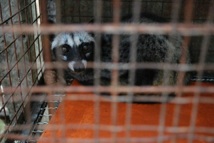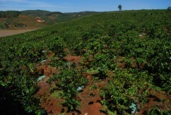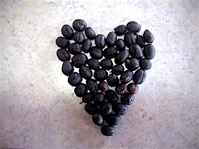Coffee / Kāfæ / กาแฟ
Coffee is a significant cash crop for both producing- and consuming-countries. Thailand is the third largest producer in Asia (after Vietnam and Indonesia), and ranks 20th in exports, globally (2). Even so, Thailand is virtually unknown in coffee circles. Ninety-eight percent of Thailand’s production is robusta — only 2% is arabica. The robusta coffee is used widely in cheap, instant coffee. But the perception of Thai coffee is now starting to change.
Click here to continue to page 2 about our coffee, Kāfæ Mūl Cĥāng™
Click here to con-tinue to page 2 about Kāfæ Mūl Chāng™



Red-ripe coffee cherries and green coffee beans.


Robusta coffee ‘trees’ and leaves are larger than those of Arabica. Photo by Tim Keating
An Akha woman picks Arabica coffee grown organically, in the shade.
Ripe coffee cherries dried in the sun.
Dried ‘green’ coffee beans, prior to roasting.
A civet, used to produce “civet” coffee, kept in
a tiny cage. Photo by Tim Keating

Mul châng cherries after drying.


Kāfæ Mūl Cĥāng™ is a project of Elephant Relief. Website copyright © 2016
Robusta coffee grown in the full sun.
Photo by Tim Keating
References
-
1.Dictionary of Gourmet Coffee Tasting, Gourmet Coffee Lovers (http://www.gourmetcoffeelovers.com/dictionary-of-gourmet-coffee-tasting/) (retrieved 6/22/14).
-
2.International Coffee Organization, Coffee Prices (http://www.ico.org/prices/po.htm) (retrieved 6/22/14).
-
3.Angkasith, Pongsak, 2001, “Coffee Production Status and Potential of Organic Arabica Coffee in Thailand”, Chiang Mai University, Paper presented at the First Asian Regional Round-table on Sustainable, Organic and Speciality Coffee Production, Processing and Marketing, 26-28 Feb. 2001, Chiang Mai, Thailand.
-
4.“Establishment of Doikham”, Doi Kham Food Products Company, Ltd., website, http://www.doikham.co.th/aboutus_en.php (retrieved 2/15/14).
-
5.National Geographic Travelers Indonesia, November 2010, page 44.
-
6.Wikipedia, Kopi Luwak (http://en.wikipedia.org/wiki/Kopi_Luwak) (retrieved 8/31/14).